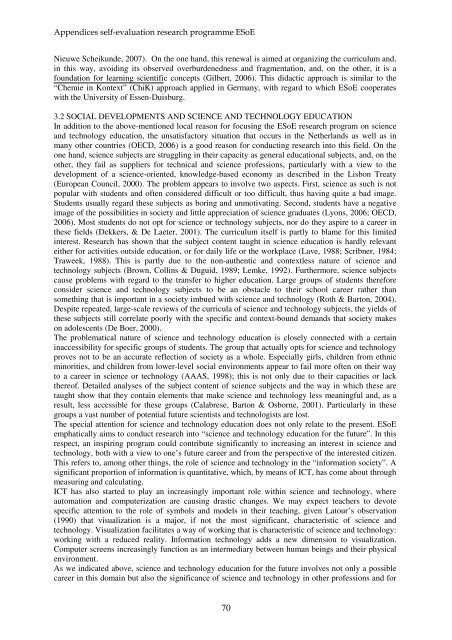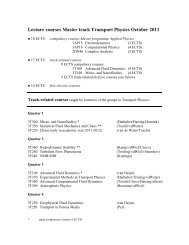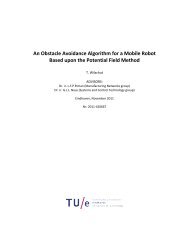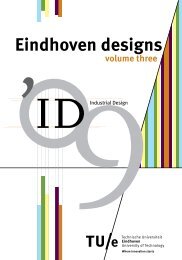Self-evaluation - Technische Universiteit Eindhoven
Self-evaluation - Technische Universiteit Eindhoven
Self-evaluation - Technische Universiteit Eindhoven
You also want an ePaper? Increase the reach of your titles
YUMPU automatically turns print PDFs into web optimized ePapers that Google loves.
Appendices self-<strong>evaluation</strong> research programme ESoE<br />
Nieuwe Scheikunde, 2007). On the one hand, this renewal is aimed at organizing the curriculum and,<br />
in this way, avoiding its observed overburdenedness and fragmentation, and, on the other, it is a<br />
foundation for learning scientific concepts (Gilbert, 2006). This didactic approach is similar to the<br />
“Chemie in Kontext” (ChiK) approach applied in Germany, with regard to which ESoE cooperates<br />
with the University of Essen-Duisburg.<br />
3.2 SOCIAL DEVELOPMENTS AND SCIENCE AND TECHNOLOGY EDUCATION<br />
In addition to the above-mentioned local reason for focusing the ESoE research program on science<br />
and technology education, the unsatisfactory situation that occurs in the Netherlands as well as in<br />
many other countries (OECD, 2006) is a good reason for conducting research into this field. On the<br />
one hand, science subjects are struggling in their capacity as general educational subjects, and, on the<br />
other, they fail as suppliers for technical and science professions, particularly with a view to the<br />
development of a science-oriented, knowledge-based economy as described in the Lisbon Treaty<br />
(European Council, 2000). The problem appears to involve two aspects. First, science as such is not<br />
popular with students and often considered difficult or too difficult, thus having quite a bad image.<br />
Students usually regard these subjects as boring and unmotivating. Second, students have a negative<br />
image of the possibilities in society and little appreciation of science graduates (Lyons, 2006; OECD,<br />
2006). Most students do not opt for science or technology subjects, nor do they aspire to a career in<br />
these fields (Dekkers, & De Laeter, 2001). The curriculum itself is partly to blame for this limited<br />
interest. Research has shown that the subject content taught in science education is hardly relevant<br />
either for activities outside education, or for daily life or the workplace (Lave, 1988; Scribner, 1984;<br />
Traweek, 1988). This is partly due to the non-authentic and contextless nature of science and<br />
technology subjects (Brown, Collins & Duguid, 1989; Lemke, 1992). Furthermore, science subjects<br />
cause problems with regard to the transfer to higher education. Large groups of students therefore<br />
consider science and technology subjects to be an obstacle to their school career rather than<br />
something that is important in a society imbued with science and technology (Roth & Barton, 2004).<br />
Despite repeated, large-scale reviews of the curricula of science and technology subjects, the yields of<br />
these subjects still correlate poorly with the specific and context-bound demands that society makes<br />
on adolescents (De Boer, 2000).<br />
The problematical nature of science and technology education is closely connected with a certain<br />
inaccessibility for specific groups of students. The group that actually opts for science and technology<br />
proves not to be an accurate reflection of society as a whole. Especially girls, children from ethnic<br />
minorities, and children from lower-level social environments appear to fail more often on their way<br />
to a career in science or technology (AAAS, 1998); this is not only due to their capacities or lack<br />
thereof. Detailed analyses of the subject content of science subjects and the way in which these are<br />
taught show that they contain elements that make science and technology less meaningful and, as a<br />
result, less accessible for these groups (Calabrese, Barton & Osborne, 2001). Particularly in these<br />
groups a vast number of potential future scientists and technologists are lost.<br />
The special attention for science and technology education does not only relate to the present. ESoE<br />
emphatically aims to conduct research into “science and technology education for the future”. In this<br />
respect, an inspiring program could contribute significantly to increasing an interest in science and<br />
technology, both with a view to one’s future career and from the perspective of the interested citizen.<br />
This refers to, among other things, the role of science and technology in the “information society”. A<br />
significant proportion of information is quantitative, which, by means of ICT, has come about through<br />
measuring and calculating.<br />
ICT has also started to play an increasingly important role within science and technology, where<br />
automation and computerization are causing drastic changes. We may expect teachers to devote<br />
specific attention to the role of symbols and models in their teaching, given Latour’s observation<br />
(1990) that visualization is a major, if not the most significant, characteristic of science and<br />
technology. Visualization facilitates a way of working that is characteristic of science and technology:<br />
working with a reduced reality. Information technology adds a new dimension to visualization.<br />
Computer screens increasingly function as an intermediary between human beings and their physical<br />
environment.<br />
As we indicated above, science and technology education for the future involves not only a possible<br />
career in this domain but also the significance of science and technology in other professions and for<br />
70

















